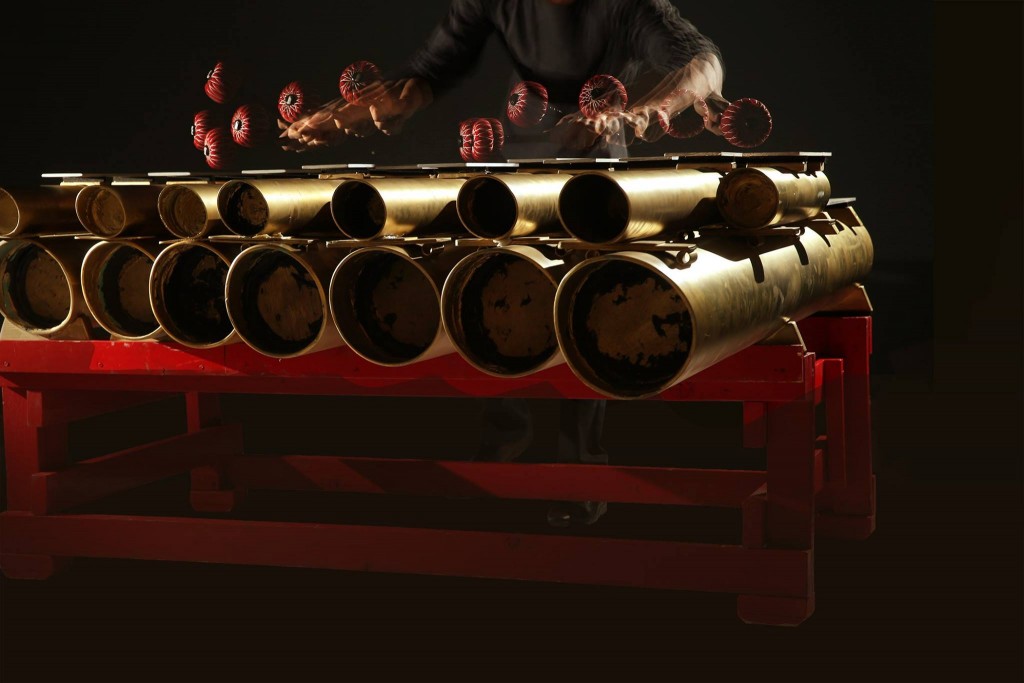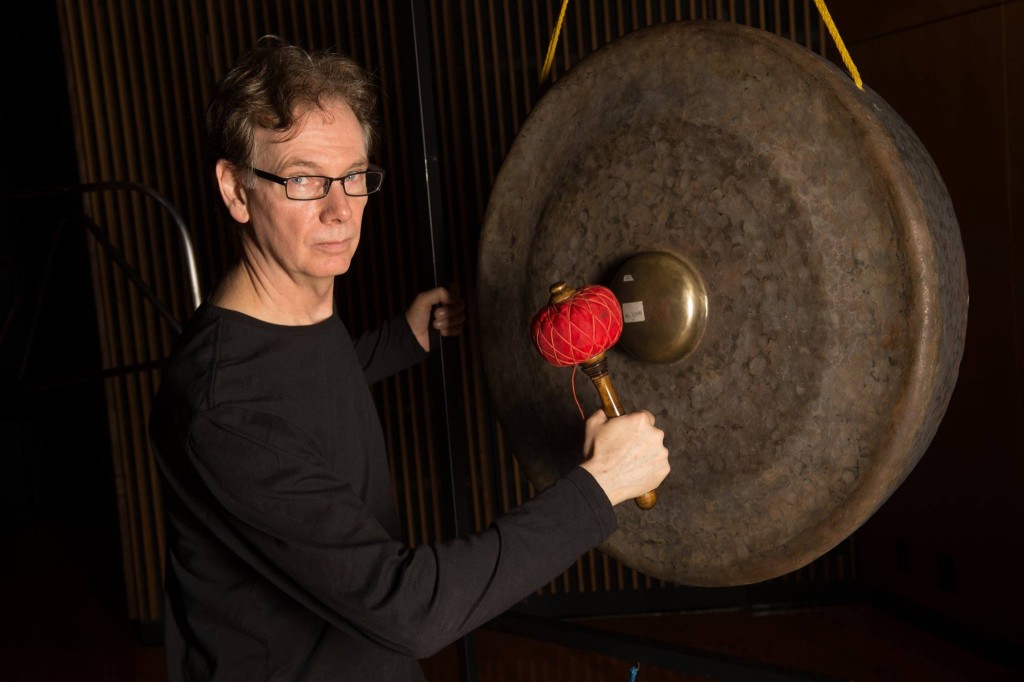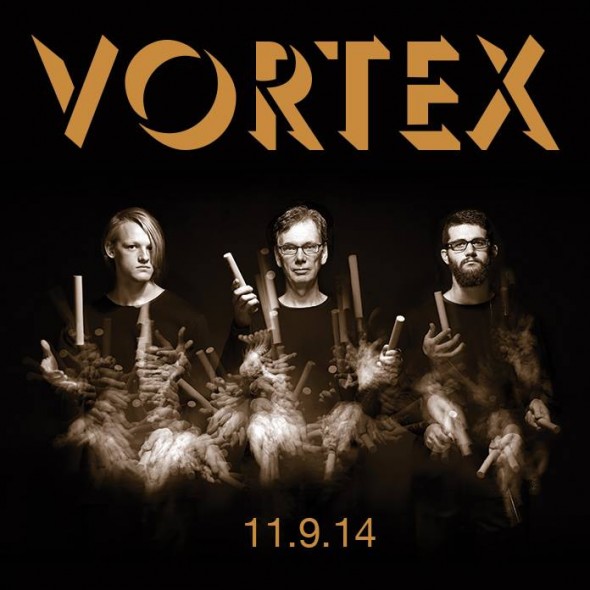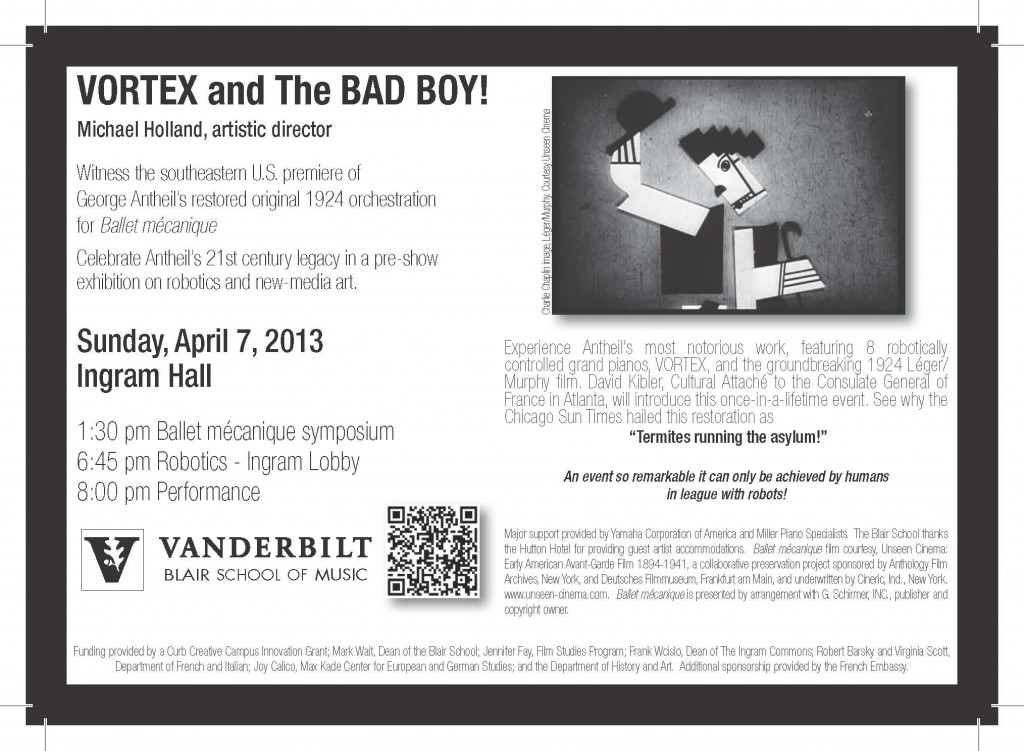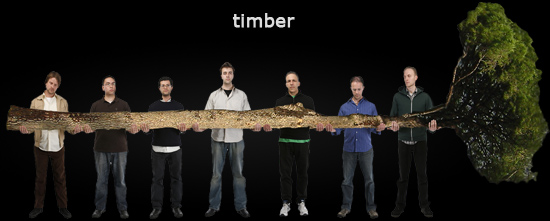Michael Holland, director of the VORTEX Percussion Ensemble at Blair School of Music, organized the concert-of-the-year for two years running: 2012’s John Cage Centennial and 2013’s Ballet Mecanique (featuring 8 robotic pianos!). 2014 came and went without a VORTEX performance on that scale, but Holland and company still managed to pack a hell of a wallop with a show featuring a live soundtrack to a Fleischer Brothers’ Koko the Clown cartoon and an expertly-choreographed rendition of Mary Ellen Childs’ Click. On Sunday, March 15th, VORTEX returns with what is sure to be 2015’s show of the year: VORTEX and the American Gamelan.
The American Gamelan is a percussion instrument loosely based on the Indonesian Gamelan. The instrument was invented and constructed by composer, maker, and radical visionary Lou Harrison and his partner William Colvig out of aluminum tubes, bars, and found materials like cans and oxygen tanks. The one at Blair School is one of only four in existence. So yeah, it’s kind of a big deal.
The daylong event begins with a documentary on Lou Harrison (watch the trailer below) and ends with performances featuring the American Gamelan. Don’t miss the MusiCircus invading the plaza at 6:45pm. The John Cage Centennial MusiCircus was one of the highlights of that event. (See the video I recorded below.) For this one, Holland says, “We’ll have musicians playing traditional Chinese guzheng, pipa, Indian tabla, a harp choir, the fabulous Bocalize bassoon septet, singers, dancers, Brazilian capoeiristas and much, much more!”
While researching this post, I wondered how early 20th century composer Henry Cowell fit into the picture. He’s mentioned in the Blair School concert announcement, yet I couldn’t find how he was associated with the American Gamelan. I reached out to Michael Holland about it, and his answer was so beautiful that I can’t help but quote it in full here:
Henry Cowell was certainly a teacher of Harrison (and Cage, Gershwin, Burt Bacharach, and scads more composers) but more important, he is the spark behind the explosion of so many things we take for granted in the 20th and even the 21st centuries in music.
Cowell is one of the inventors of the percussion orchestra. Growing up immersed in the multi-cultural world of the San Francisco Bay Area, Cowell was the first composer to reach inside the piano to create sounds beyond those produced by the keyboard, pioneering the use of tone clusters, chance operations, and complex polyrhythms.
He was the first strong advocate for what we commonly refer to as “world music.” Cowell was the instigator behind Harrison’s and Cage’s forays into non-Western music.
But it gets better still! Cowell urged his students to forgo the dicey world of writing for orchestras and to, instead, forage through junk yards for found sounds. Here’s where it gets interesting and directly connected to the gamelan. In these “found sounds” we hear the first strains of what would become–under Lou Harrisons direction–the creation of the American Gamelan.
Cowell’s pursuit of metallophones included spun steel brake drums, steel pipe, bell plates (flat plates of steel) –ringing things, all of them–and in these sounds you will hear something that reminds you of the Balinese Gamelan. You’ll hear this in two pieces: Cowell’s Pulse, written in 1939 and Lou Harrison’s The Song of Quetzalcoatl (1942). We’ll demonstrate this on Sunday night. The audience is in for a special treat because spun steel brake drums are extraordinarily difficult to find. I have one of the few sets in the country. NOTE: Lou Harrison remarked shortly before his death in 2003 just how frustrated he was that no one seemed to care enough to bother collecting the authentic sounds for which he had written–much less go to the trouble of actually suspending them so they ring.
What audiences will note is that spun steel brake drums ring like Buddhist Temple bells….25-30 seconds of reverberation. They are gorgeous–from cars in the 1930s. (The automotive standard became cast iron in the 1950s.)
So, there you go. Cowell leads us to Harrison who builds the American Gamelan.
It’s this kind of attention to detail that makes Michael Holland one of the Nashville art scene’s greatest assets. Blair School should count themselves extremely fortunate to have him.
More from the Blair School:
Celebrating the world music legacy of Henry Cowell and Lou Harrison. East meets West in an orchestra built entirely of shimmering, ethereal metal. “The most beautiful instrument on the planet,” according to Lou Harrison.
Experience the beauty of the American Gamelan after its 900-mile journey to Nashville. See and hear this unforgettable orchestra of metal — one of only four in the world — and explore the cultural frontiers opened by Cowell and Harrison. Rare archival photographs, audio clips and historic film footage let Cowell and Harrison speak to you as VORTEX presents the Southeastern U.S. debut of the American Gamelan.
Violinist Carolyn Huebl performs Harrison’s Suite for Violin and American Gamelan, and composer John Pennington leads the Tennessee premiere of his new work Gitanjali, with soloist Cyprian Consiglio.
- Noon: Documentary film: LOU HARRISON: A World of Music, Portrait of a great composer who followed his own dreams. Trading a fast-paced New York career for a cabin in the woods, Harrison embraced “world music” before the term was invented, Choral Hall
- 1:30 p.m.: Break: Coffee and fresh-from-the-oven cookies!
- 2 p.m.: Not sure what a gamelan is? See and hear the American Gamelan in a rare and up close setting with John Pennington, Choral Hall
- 2:45 p.m.: Informal concert with Cyprian Consiglio and John Pennington, featuring hand percussion, guitar and vocal music from the traditions of the Camaldolese monks, Choral Hall
- 6:45 p.m.: MusiCircus for Henry Cowell and Lou Harrison. Enter the imaginative world of Cowell and Harrison in an interactive exploration of sound and movement. This MusiCircus is a menagerie of sounds from West Africa, Brazil, China, Japan, India, America, and much more. Created in the festive spirit of John Cage, “You won’t hear a thing. You’ll hear everything!” Fun for the whole family! Ingram Lobby and Plaza.
- 8 p.m.: VORTEX concert (recommended minimum age: 5), Ingram HallCelebrating the world music legacy of Henry Cowell and Lou Harrison. East meets West in an orchestra built entirely of shimmering, ethereal metal. “The most beautiful instrument on the planet,” according to Lou Harrison.
VORTEX and the American Gamelan
Sunday, March 15th, 2015, noon to 10pm.
Blair School of Music, Nashville, TN

